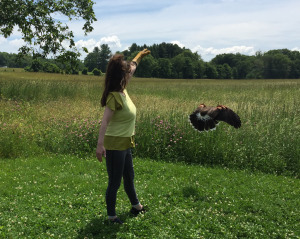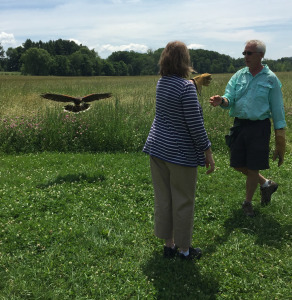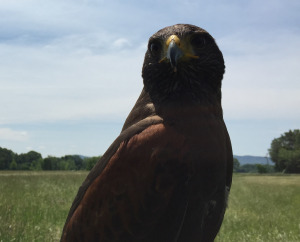Hawks
“It would affect our thoughts, deepen and perchance darken our reflections, if such huge birds flew in numbers in our sky.”
Henry David Thoreau was referring to blue herons in this April 19, 1852 journal entry, but witnessing big, fierce, or even ordinary birds can change us. Yesterday my friend Jess dressed like a tree with dark pants, a green top, and some of her hair twisted into a nest on top as we had a chance to meet birds at New England Falconry.
Six of us sat on a shady bench in front of four tethered hawks as Chris Davis, master falconer with an advanced degree in Resource Management, told us some about the history of falconry. Records go back more than two thousand years, showing that falconry began as a way for people to share what hawks hunted. Falconry moved through Africa and the Middle East to a history more familiar to many of us: the Medieval and Renaissance men and women wearing cloaks and long leather gloves. There’s only about a hundred years of falconry history in the United States, where the first settlers were more likely to shoot than become allies with birds of prey. Falconry gained ground after two women, aghast at the slaughter done to provide feathers for fashionable hats, helped found Mass Audubon in 1896.
Some of us came with some mythology that’s explored, with much else, particularly all the guises of grief, in Helen Macdonald’s gritty and gorgeous memoir, H is for Hawk, which I’m reading now. Chris is all scientist. He gave us facts about varieties of birds of prey, habits, weights, the sharp eyesight and swiveling necks, and flight speeds (with the Harris hawks here can fly 30 to 40 mph, compared to the 200 plus mph of peregrine falcons.) When Jess asked him if his hawks had names, he told us they had numbers. When she asked if they had fun, he explained that he can only consider fun in terms of what animals do to survive.
Jess and I were scared and excited as we walked past multiflora roses, bent cattails, through fields of grass, buttercups, and clover. Those clawed feet look kind of crazy, and those beaks are sharp. But the hawks were as disciplined as promised. Chris’s calm presence helps keep the great birds on task and was a perfect backdrop for our marveling at the birds’ swooping arcs, the shapes of their wings, the wonder of their approximately two pound selves lighting on our gloved hands, then sweeping off as we swung back our arms. We left more attentive to what’s in the sky or trees, what’s on the ground, and the briefly visible magnificence in between. The world a little larger than we’d known.








